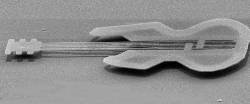18 January 1999
Self Building Robots Begin Their March
 In one of the first examples of molecules building themselves into useful synthetic microstructures with little human intervention, chemical engineers have created plastic materials that assemble themselves into sophisticated optical devices known as photonic crystals. Samson Jenekhe and Linda Chen of the University of Rochester describe their work on a process known as "hierarchical self-assembly" in the Jan. 15 issue of Science.
In one of the first examples of molecules building themselves into useful synthetic microstructures with little human intervention, chemical engineers have created plastic materials that assemble themselves into sophisticated optical devices known as photonic crystals. Samson Jenekhe and Linda Chen of the University of Rochester describe their work on a process known as "hierarchical self-assembly" in the Jan. 15 issue of Science.
Just last year the same team created the largest synthetic structures ever made by self-assembly, where molecules organize themselves into discrete microscopic objects, such as hollow spheres. In the current work they've gone one step further, developing methods to make billions of those objects come together to form even larger, highly ordered structures visible to the naked eye. The materials are an intricate 3-D composite of air and plastic that manipulate light in the same way that allows opals to produce such striking colors. That's because the materials exhibit "spatial periodicity," a sought-after characteristic that refers to their high degree of order and their optical properties.
The structures themselves don't appear extraordinary; they're simply thin films that coat glass slides. But they do hint at their optical qualities, reflecting the colors of the rainbow like a hologram on a credit card. Under a microscope, the detail and order of the materials is striking: Beneath the sheen, hollow plastic spheres pack together to form a three-dimensional structure that looks like a honeycomb. (Jenekhe points out that there are other optical devices actually called honeycombs, but those 2-D devices are quite different from these 3-D structures).
"This is the next logical step in self-assembly," says Jenekhe, the lead investigator and professor of chemical engineering, chemistry, and materials science. "We start with polymer molecules in solution. They self-organize into hollow spheres, and billions and billions of them come together in a precise, ordered way to form a larger periodic structure."
